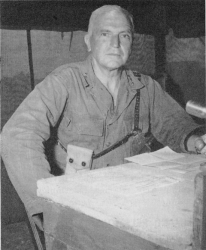FROM MILITARY HALL OF VALOR:
imon Bolivar Buckner, Jr.
General, U.S. Army
Simon Bolivar Buckner, Jr. was born on 18 July 1886 in Munfordville, Hart County, KY. His father was Confederate General Simon Bolivar Buckner, Sr., who surrendered to Ulysses S. Grant at Fort Donelson and was Governor of the Commonwealth of Kentucky from 1887-1891.
Buckner was raised in the rural hills of western Kentucky near Munfordville, and attended Virginia Military Institute (VMI). He later won an appointment to the U.S. Military Academy (Class of 1908) from President Theodore Roosevelt. He served two tours of duty in the Philippines. During World War I, he served as a temporary Major, drilling discipline into budding aviators.
Inter-War Years
Between the wars, Buckner returned to West Point as an instructor (1919-23) and again as instructor and Commandant of Cadets (1932-36). Though recognized as tough and fair, his insistence on developing cadets past conventional limits caused one parent to quip, "Buckner forgets that cadets are born, not quarried." He was also an instructor at the General Service Schools at Fort Leavenworth, KS, and was executive officer at the Army War College in Washington, DC.
Alaska
Prior to the Japanese attack on Pearl Harbor on 7 December 1941, Buckner was promoted to Brigadier General and assigned to fortify and protect Alaska as commander of the Army's Alaska Defense Command. Though comparatively quiet, there was some action with the attack on Dutch Harbor (3-5 June 1942); the Japanese seizure of the islands Kiska and Attu (June 1942); Battle of Attu (Operation Landcrab, May 1943); and "invasion" of Kiska (August, 1943).
Battle of Okinawa
In July 1944, Buckner was sent to Hawaii to organize the 10th Army, which was composed of both Army and Marine units. The original mission of the 10th Army was to prepare for the invasion of Taiwan. However, this operation was canceled and Buckner's command was instead ordered to prepare for the Battle of Okinawa. This turned out to be the largest, slowest, and bloodiest sea-land-air battle in American military history. According to an eyewitness account, on 18 June 1945, Lieutenant General Buckner had arrived in his command jeep, which was flying its standard 3-star flag, to inspect a forward observation post. Visits from the general were not always welcome as his presence frequently drew enemy fire, which fortunately, usually happened as General Buckner was departing. However, on the 18th Buckner had arrived with his standard bright three stars showing on his steel helmet and a nearby Marine outpost sent a signal to Buckner's position stating that they could clearly see the three stars on the general's helmet. Told of this, Buckner replaced his own helmet with an unmarked one. However, the Imperial Japanese Army artillery (Type 96 15 cm Howitzer) position had already observed General Buckner and commenced fire upon his position; exploding shrapnel tore into his chest. Buckner was carried by stretcher to a nearby aid station where he died on the operating table. Colonel Clarence R. Wallace and PFC Harry M. Sarkisian were at his side when he died.
Buckner was the highest-ranking U.S. military officer killed by enemy fire during World War II; he was also one of the highest-ranking military officers to die during the war.
He was succeeded in command by Marine General Roy Geiger. Total American deaths during the battle of Okinawa were 12,513.
Posthumous Promotion
Lieutenant General Simon Bolivar Buckner, Jr. was posthumously promoted to the rank of four-star general on 19 July 1954 by a Special Act of Congress (Public Law 83-508).
[Eleven lieutenant generals (including Buckner) were promoted to 4-star rank on 19 July 1954. Seven promotions were granted to living retirees; four were awarded posthumously.]
Medals and Awards
Distinguished Service Cross
Army Distinguished Service Medal
Navy Distinguished Service Medal
Purple Heart
World War I Victory Medal
American Defense Medal
American Campaign Medal
Asiatic-Pacific Campaign Medal
World War II Victory Medal
Distinguished Service Cross Citation (Synopsis)
Lieutenant General Simon Bolivar Buckner, Jr. (ASN: 0-2370), United States Army, was awarded the Distinguished Service Cross (Posthumously) for extraordinary heroism in connection with military operations against an armed enemy while serving as Commanding General of the TENTH Army, in action against enemy forces on 18 June 1945. Lieutenant General Buckner's intrepid actions, personal bravery and zealous devotion to duty at the cost of his life, exemplify the highest traditions of the military forces of the United States and reflect great credit upon himself, his unit, and the United States Army.
General Orders: Headquarters, U.S. Army Forces-Middle Pacific, General Orders No. 5 (1945)
Honors
• Fort Buckner, an Army sub-post of the Marine Corps' Camp Foster on Okinawa, is home to the 58th Signal Battalion and includes a small memorial to its namesake.
• Nakagusuku Bay on the East side of Okinawa was briefly nicknamed "Buckner Bay" in the 1940s.
• West Point's Camp Buckner, where yearlings (incoming sophomores) go through Cadet Field Training (CFT).
• Several places built in Alaska during Cold War-related military construction, including:
• Buckner Gymnasium (also Fieldhouse and Physical Fitness Center) at Fort Richardson (now part of Joint BaseElmendorf-Richardson) in Anchorage,Alaska, a postwhich the general established during World War II.
• The Buckner Building in Whittier,Alaska, once thelargest building in Alaska by square footage.
• Buckner Drivein the Nunaka Valley subdivision of Anchorage, originally built asmilitary housing.
Death and Burial
Lieutenant General Simon Bolivar Buckner, Jr. was killed in action by enemy artillery fire on 18 June 1945, during the closing days of the Battle of Okinawa. He is interred in the family plot at Frankfort Cemetery in Frankfort, KY.

PRIVATE CITIZENS SUPPORTING AMERICA'S HERITAGE
American
War Memorials Overseas, Inc.
War Memorials Overseas, Inc.
Buckner Simon Bolivar Jr.
Name:
Simon Bolivar Jr. Buckner
Rank:
Lieutenant General
Serial Number:
Unit:
10th Army (Operation Iceberg)
Date of Death:
1945-06-18
State:
Kentucky
Cemetery:
Frankfort Cemetery, Frankfort, Franklin County, Kentucky
Plot:
Frankfort Cemetery Frankfort, Franklin County, Kentucky
Row:
Grave:
Decoration:
Distinguished Service Cross
Comments:
